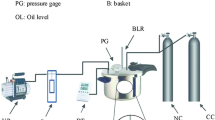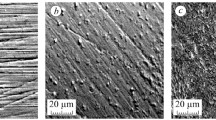Abstract
Autoxidative deterioration of three commercial mineral spray oils was studied by measuring oxygen absorption under atmospheric conditions and by an accelerated method in the laboratory. The outdoor experiment showed an absorption of 0.02-0.25 moles of oxygen per mole of oil during the first 5 days, which increased to 0.13-0.42 moles after 20 days of exposure. The oxygen absorption was accompanied by separation of insoluble tar-like substances. The relative rates of the autoxidation of the three oils were found to be in agreement with their tendency to cause excessive fruit drop.
Accelerated autoxidation was performed under controlled conditions of temperature, light spectrum and relative light intensity; it was accomplished in several hours and gave approximately the same results as the outdoor experiment. The accelerated procedure is closely correlated with the atmospheric one and thus is suitable as a routine test for spray oils, for mineral oil fraction or formu-lations, and for mixtures of oils with other pesticides.
Similar content being viewed by others
References
Bondi, A. (1951) Physical Chemistry of Lubricating Oil. Reinhold Publ. Co., New York, N.Y. p. 270.
Griffiths, A.E. and Janes, M.J. (1952) Phytotoxic and insecticidal study of a petroleum isoparaffinic fraction.Adv. Chem. Ser. 7: 37–42.
Johnson, C.M. and Hoskins, W.M. (1952) The relation of acids and peroxides in spray oils to the respiration of sprayed bean leaves and the development of injury.Pl. Physiol., Lancaster 27: 507–525.
Riehl, L.A. (1967) Characterization of petroleum oils for the control of pests of citrus.J. agric. Fd Chem. 15: 878–882.
Riehl, L.A. (1969) Advances relevant to narrow-range spray oils for citrus pest control.Proc. 1st Int. Citrus Symp., Riverside2: 897–908.
Sachanen, A.N. (1945) The Chemical Constituents of Petroleum. Reinhold Publ. Co., New York, N.Y. p. 338, 390.
Scott, G. (1965) Atmospheric Oxidation and Antioxidants. Elsevier Publ., Amsterdam.
Shepard, H.H. (1951) The Chemistry and Action of Insecticides. McGraw-Hill, New York, N.Y.
Simanton, W.A. and Trammel, K. (1966) Recommended specifications for citrus spray oils in Florida.Citrus Ind. 47(12): 21–24.
Tucker, R.P. (1936) Chemical properties of petroleum oil unsaturates causing injury to foliage.Ind. Engng Chem. ind. Edn 28: 458–461.
Uri, N. (1970) Some aspects of thermal and photochemical autoxidation.Israel J. Chem. 8: 125–139.
Van Overbeek, J. and Blendeau, R. (1954) Mode of action of phytotoxic oils.Weeds 3: 55–65.
Veierov, D., Erner, Y., Shomer, I. and Aharonson, N. (1979) Early evaluation of orange peel blotches caused by spray oils.Phytoparasitica 7: 79–88.
Author information
Authors and Affiliations
Rights and permissions
About this article
Cite this article
Veierov, D., Aharonson, N. Measurements of atmospheric deterioration of citrus spray oils. Phytoparasitica 7, 89–98 (1979). https://doi.org/10.1007/BF02981581
Received:
Issue Date:
DOI: https://doi.org/10.1007/BF02981581




